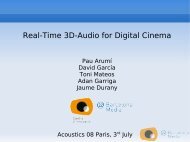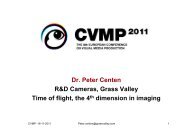EBU tech-i edition 8 - EBU Technical
EBU tech-i edition 8 - EBU Technical
EBU tech-i edition 8 - EBU Technical
Create successful ePaper yourself
Turn your PDF publications into a flip-book with our unique Google optimized e-Paper software.
in focus<br />
MPEG-7 Profile for Automatic Metadata<br />
Extraction in Media Production 1<br />
Werner Bailer of Joanneum Research and Masanori Sano<br />
of NHK take a look at the next phase in the automation of<br />
audiovisual media production.<br />
After building a more efficient IT-based<br />
production infrastructure, the next logical<br />
step in the automation of audiovisual media<br />
production is the widespread adoption of<br />
automatic metadata extraction tools, such<br />
as temporal content segmentation (e.g.,<br />
shots, scenes, news stories), automatic<br />
speech recognition, named entity detection,<br />
copy and near duplicate detection or content<br />
summarisation. The study and evaluation<br />
of content analysis-based automatic<br />
information extraction tools is the task of the<br />
<strong>EBU</strong> ECM/SCAIE 2 group , established in<br />
2007. A key issue hindering the exploitation<br />
of the full potential of these tools is the lack<br />
of an interoperable representation of their<br />
results, and hence, the difficulty of integrating<br />
them in production infrastructures and of<br />
automatically evaluating the performance<br />
of different tools. Thus the group addressed<br />
this issue by defining a common interchange<br />
metadata profile based on the MPEG-7<br />
standard 3 .<br />
MPEG-7 is an excellent choice for<br />
describing audiovisual content, mainly<br />
because of its comprehensiveness and<br />
flexibility, providing a number of description<br />
tools, from low-level visual and audio<br />
descriptors to semantics. The standard<br />
has been designed for a broad range of<br />
applications and thus employs very general<br />
and widely applicable concepts. However,<br />
two main problems arise from the generic<br />
and flexible tools in the practical use of<br />
MPEG-7: complexity and interoperability<br />
issues, resulting in hesitance in adopting<br />
the standard and a lack of interoperable<br />
tools. Full interoperability is only possible<br />
with knowledge about how the standard has<br />
been used. This means that an additional<br />
layer of definitions is necessary to enable full<br />
interoperability on a semantic level.<br />
Like in other MPEG standards, profiles<br />
covering specific applications have been<br />
introduced in MPEG-7 4 . Profiles can support<br />
interoperability by selecting tools and defining<br />
additional constraints. Interoperability can<br />
be considered in profile design by avoiding<br />
ambiguities and enforcing a single way to<br />
model semantically identical descriptions.<br />
The three existing profiles do not resolve the<br />
interoperability issues as they restrict the set<br />
of description tools included in the profile,<br />
but define only few constraints on their<br />
semantics. In addition, they exclude powerful<br />
low-level audio and video descriptors.<br />
Mpeg7<br />
Description type=“ContentEntityType”<br />
MultimediaContent type=“AudioVisualType”<br />
AudioVisual<br />
TD<br />
MSD MSD<br />
The profile developed by ECM/SCAIE,<br />
named Audiovisual Description Profile (AVDP),<br />
addresses these issues. It harmonises profiles<br />
developed in some of the organisations<br />
contributing to the group, and further simplifies<br />
the use of MPEG-7. An AVDP document<br />
contains descriptions of one or more<br />
audiovisual contents and/or the description of<br />
a summary of a single or a set of contents. The<br />
profile supports the description of audio, video<br />
or audiovisual content, ensuring a compatible<br />
document structure for all types. A key feature<br />
of AVDP is the modularity in the descriptions<br />
(e.g., separating metadata originating from<br />
different modalities or produced by different<br />
tools). Figure 1 visualises the structure of<br />
an AVDP document: the top level contains<br />
the temporal/editorial structure, the second<br />
level the different modalities or more detailed<br />
temporal/editorial structure, and the third the<br />
(spatio) temporal structure within modalities (if<br />
applicable).<br />
AVDP, which is the first profile based on<br />
version 2 of MPEG-7, has been proposed<br />
as amendment to part 9 of MPEG-7 and is<br />
expected to become an ISO/IEC standard<br />
by summer 2011. A web-based service<br />
for the automatic syntactic and semantic<br />
validation of AVDP documents has been<br />
implemented 5 .<br />
TD: TemporalDecomposition<br />
STD: SpatioTemporalDecomposition<br />
MSD: MediaSourceDecomposition<br />
SD: SpatialDecomposition<br />
AVS AVS AVS<br />
TD AVS AVS AVS<br />
TD AVS AVS AVS<br />
(Container)<br />
T<br />
AVS-1 st<br />
Same duration<br />
T Text<br />
V Video feature + Text<br />
A Audio feature + Text<br />
Figure 1<br />
TD TD<br />
T<br />
AVS-2 nd<br />
AVS<br />
VS AS<br />
VS-key AS<br />
AS AS-key<br />
V<br />
A<br />
TD TD<br />
STD STD<br />
TD TD<br />
TD TD<br />
ECM/SCAIE has started to collect a data<br />
set for the evaluation of content analysis<br />
tools 6 , consisting of real-world content from<br />
media production and including ground<br />
truth annotations. The group is currently<br />
collecting a list of available automatic<br />
analysis tools for audiovisual content, with<br />
the aim of evaluating these tools on the data<br />
set. Both the ground truth annotations and<br />
the results obtained from the analysis tools<br />
will be represented using AVDP. For tools<br />
that are adopted in production processes,<br />
AVDP can serve as an interoperable format<br />
for representing their output.<br />
1<br />
The research leading to these results has received<br />
funding from the European Union’s Seventh<br />
Framework Programme under grant agreements no.<br />
FP7-231161, “PrestoPRIME”<br />
(http://www.prestoprime.eu), and FP7-215475,<br />
“2020 3D Media” (http://www.20203dmedia.eu).<br />
2<br />
http://<strong>tech</strong>.ebu.ch/groups/pscaie<br />
3<br />
Information <strong>tech</strong>nology – Multimedia content<br />
description interface. ISO/IEC 15938:2004.<br />
4<br />
Information <strong>tech</strong>nology – Multimedia content<br />
description interface – Profiles and levels. ~ISO/IEC<br />
15938-9:2005.<br />
5<br />
http://vamp.joanneum.at<br />
AVS: AudioVisualSegment<br />
AS: AudioSegment<br />
VS: VideoSegment<br />
SR: StillRegion<br />
MR: MovingRegion<br />
( e.g., criteria=shot )<br />
( e.g., criteria=ASR )<br />
( e.g., criteria=Face )<br />
VS VS V<br />
AS AS A<br />
AVS-3 rd<br />
MR<br />
6<br />
The data set is hosted by the Mammie system at<br />
http://media.ibbt.be/mammie<br />
V<br />
VideoText<br />
SR SR<br />
V SD SD<br />
SR V<br />
Frame<br />
ImageText<br />
T<br />
08 <strong>tech</strong>-i | http://<strong>tech</strong>.ebu.ch | june 2011





